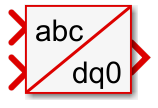Table of Contents
The “abc to dq0” block computes the coordinates of a three-phase (abc) signal in a rotating reference frame (dq0). The angle of the rotating reference frame is given by the second input \(\theta=\omega t\).
The transformation is performed by applying successively an abc to alpha-beta-0, and an alpha-beta-0 to dq0 transformation:
$$ \begin{bmatrix} V_d\\V_q\\V_0\end{bmatrix}
= \frac{2}{3}\cdot
\begin{bmatrix} \cos\theta & \sin\theta & 0 \\ -\sin\theta & \cos\theta & 0 \\ 0 & 0 & 1\end{bmatrix}\cdot
\begin{bmatrix} 1 & -1/2 & -1/2\\0 & \sqrt{3}/2 & -\sqrt{3}/2\\ 1/2 & 1/2 & 1/2\end{bmatrix}\cdot
\begin{bmatrix} V_a\\V_b\\V_c\end{bmatrix}$$
Simulink block
Signal specification
- The first input is a vector of dimension 3, containing the abc components of the three-phase signal.
- The second input is the angle \(\theta\) of the rotating reference frame, in radians.
- The output is a vector of dimension 3, containing the dq0 components of the three-phase signal in the rotating reference frame.
Parameters
None.
PLECS block
None. The PLECS block Transformation 3ph->RRF can be used instead.
C++ functions
The user template located in the installation folder of CPP SDK contains an API folder with implementations of the coordinate transformation functions. The abc to dq0 function is the following:
void abc2DQ0(SpaceVector* rotating, const TimeDomain* physical, const float theta);
Code language: C++ (cpp)Parameters
rotating: pointer on the dq0 space vector that will be updated. TheSpaceVectorstructure is defined below.physical: pointer on the time domain abc data that will be transformed. TheTimeDomainstructure is defined below.- theta: the angle of the rotating reference frame, in radians.
typedef struct{
float real; // d-axis component
float imaginary; // q-axis component
float offset; // homopolar component
} SpaceVector;
typedef struct{
float A;
float B;
float C;
} TimeDomain;Code language: C++ (cpp)


